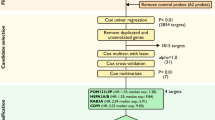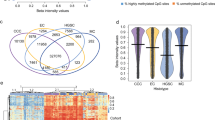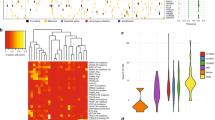Abstract
Profiles of gene transcription have begun to delineate the molecular basis of ovarian cancer, including distinctions between carcinomas of differing histology, tumor progression and patient outcome. However, the similarities and differences among the most commonly diagnosed noninvasive borderline (low malignant potential, LMP) lesions and invasive serous carcinomas of varying grade (G1, G2 and G3) have not yet been explored. Here, we used oligonucleotide arrays to profile the expression of 12 500 genes in a series of 57 predominantly stage III serous ovarian adenocarcinomas from 52 patients, eight with borderline tumors and 44 with adenocarcinomas of varying grade. Unsupervised and supervised analyses showed that LMP lesions were distinct from high-grade serous adenocarcinomas, as might be expected; however, well-differentiated (G1) invasive adenocarcinomas showed a strikingly similar profile to LMP tumors as compared to cancers with moderate (G2) or poor (G3) cellular differentiation, which were also highly similar. Comparative genomic hybridization of an independent cohort of five LMP and 63 invasive carcinomas of varying grade demonstrated LMP and G1 were again similar, exhibiting significantly less chromosomal aberration than G2/G3 carcinomas. A majority of LMP and G1 tumors were characterized by high levels of p21/WAF1, with concomitant expression of cell growth suppressors, gadd34 and BTG-2. In contrast, G2/G3 cancers were characterized by the expression of genes associated with the cell cycle and by STAT-1-, STAT-3/JAK-1/2-induced gene expression. The distinction between the LMP-G1 and G2–G3 groups of tumors was highly correlated to patient outcome (χ2 for equivalence of death rates=7.681189; P=0.0056, log-rank test). Our results are consistent with the recent demonstration of a poor differentiation molecular ‘meta-signature’ in human cancer, and underscore a number of cell-cycle- and STAT-associated targets that may prove useful as points of therapeutic intervention for those patients with aggressive disease.
This is a preview of subscription content, access via your institution
Access options
Subscribe to this journal
Receive 50 print issues and online access
$259.00 per year
only $5.18 per issue
Buy this article
- Purchase on Springer Link
- Instant access to full article PDF
Prices may be subject to local taxes which are calculated during checkout





Similar content being viewed by others
References
Alo PL, Visca P, Marci A, Mangoni A, Botti C and Di Tondo U . (1996). Cancer, 77, 474–482.
Anttila MA, Kosma VM, Hongxiu J, Puolakka J, Juhola M, Saarikoski S and Syrjanen K . (1999). Br. J. Cancer, 79, 1870–1878.
Armstrong SA, Staunton JE, Silverman LB, Pieters R, den Boer ML, Minden MD, Sallan SE, Lander ES, Golub TR and Korsmeyer SJ . (2002). Nat. Genet., 30, 41–47.
Arnold N, Hagele L, Walz L, Schempp W, Pfisterer J, Bauknecht T and Kiechle M . (1996). Genes Chromosomes Cancer, 16, 46–54.
Auersperg N, Ota T and Mitchell GW . (2002). Int. J. Gynecol. Cancer, 12, 691–703.
Berek JS, Thomas GM and Ozols RF . (2000). Cancer Medicine e.5 Bast RCJ, Kufe DW, Pollack JR, Weichselbaum RR, Holland JF and Frei EI (eds). BC Decker Incorporated: London, pp. 1687–1720.
Broggini M, Buraggi G, Brenna A, Riva L, Codegoni AM, Torri V, Lissoni AA, Mangioni C and D'Incalci M . (2000). Anticancer Res., 20, 4835–4840.
Caduff RF, Svoboda-Newman SM, Ferguson AW, Johnston CM and Frank TS . (1999). Am. J. Surg. Pathol., 23, 323–328.
Capranico G, Giaccone G and D'Incalci M . (1999). Cancer Chemother Biol. Response Modif., 18, 125–143.
Chan WY, Cheung KK, Schorge JO, Huang LW, Welch WR, Bell DA, Berkowitz RS and Mok SC . (2000). Am. J. Pathol., 156, 409–417.
Collins Y, Tan DF, Pejovic T, Mor G, Qian F, Rutherford T, Varma R, McQuaid D, Driscoll D, Jiang M, Deeb G, Lele S, Nowak N and Odunsi K . (2004). Int. J. Mol. Med., 14, 43–53.
Eisen MB, Spellman PT, Brown PO and Botstein D . (1998). Proc. Natl. Acad. Sci. USA, 95, 14863–14868.
Gansler TS, Hardman III W, Hunt DA, Schaffel S and Hennigar RA . (1997). Hum. Pathol., 28, 686–692.
Gemignani ML, Schlaerth AC, Bogomolniy F, Barakat RR, Lin O, Soslow R, Venkatraman E and Boyd J . (2003). Gynecol. Oncol., 90, 378–381.
Gershenson DM . (2002). Best Pract. Res. Clin. Obstet. Gynaecol., 16, 513–527.
Golub TR, Slonim DK, Tamayo P, Huard C, Gaasenbeek M, Mesirov JP, Coller H, Loh ML, Downing JR, Caligiuri MA, Bloomfield CD and Lander ES . (1999). Science, 286, 531–537.
Hamilton SR . (1992). J. Cell. Biochem. Suppl., 16G, 41–46.
Hampton GM . (2003). Expression Profiling of Human Tumors Ladanyi M and Gerald WL (eds). Humana Press: Totowa, pp. 277–294.
Hanahan D and Weinberg RA . (2000). Cell, 100, 57–70.
Hellstrom I, Raycraft J, Hayden-Ledbetter M, Ledbetter JA, Schummer M, McIntosh M, Drescher C, Urban N and Hellstrom KE . (2003). Cancer Res., 63, 3695–3700.
Henriksen R, Strang P, Backstrom T, Wilander E, Tribukait B and Oberg K . (1994). Anticancer Res., 14, 603–608.
Hollander MC, Poola-Kella S and Fornace Jr AJ . (2003). Oncogene, 22, 3827–3832.
Iwabuchi H, Sakamoto M, Sakunaga H, Ma YY, Carcangiu ML, Pinkel D, Yang-Feng TL and Gray JW . (1995). Cancer Res., 55, 6172–6180.
Jazaeri AA, Lu K, Schmandt R, Harris CP, Rao PH, Sotiriou C, Chandramouli GV, Gershenson DM and Liu ET . (2003). Mol. Carcinogen., 36, 53–59.
Kiechle M, Jacobsen A, Schwarz-Boeger U, Hedderich J, Pfisterer J and Arnold N . (2001). Cancer, 91, 534–540.
Kim JH, Herlyn D, Wong KK, Park DC, Schorge JO, Lu KH, Skates SJ, Cramer DW, Berkowitz RS and Mok SC . (2003). Clin. Cancer Res., 9, 4782–4791.
Kim JH, Skates SJ, Uede T, Wong KK, Schorge JO, Feltmate CM, Berkowitz RS, Cramer DW and Mok SC . (2002). JAMA, 287, 1671–1679.
Korkolopoulou P, Vassilopoulos I, Konstantinidou AE, Zorzos H, Patsouris E, Agapitos E and Davaris P . (2002). Gynecol. Oncol., 85, 404–414.
Krajewski S, Bodrug S, Gascoyne R, Berean K, Krajewska M and Reed JC . (1994). Am. J. Pathol., 145, 515–525.
Krajewski S, Krajewska M, Turner BC, Pratt C, Howard B, Zapata JM, Frenkel V, Robertson S, Ionov Y, Yamamoto H, Perucho M, Takayama S and Reed JC . (1999). Endocr. Relat. Cancer, 6, 29–40.
Kreipe H, Wacker HH, Heidebrecht HJ, Haas K, Hauberg M, Tiemann M and Parwaresch R . (1993). Am. J. Pathol., 142, 1689–1694.
Kuo ML, Duncavage EJ, Mathew R, den Besten W, Pei D, Naeve D, Yamamoto T, Cheng C, Sherr CJ and Roussel MF . (2003). Cancer Res., 63, 1046–1053.
Liu KD, Gaffen SL and Goldsmith MA . (1998). Curr. Opin. Immunol., 10, 271–278.
Lockhart DJ, Dong H, Byrne MC, Follettie KT, Gallo MV, Chee MS, Mittmann M, Wang C, Kobayashi M, Horton H and Brown EL . (1996). Nat. Biotechnol., 14, 1675–1680.
Luo C and Laaja P . (2004). Drug Discov. Today, 9, 268–275.
Marx D, Meden H, Brune T, Kron M, Korabiowska M, Kuhn W and Schauer A . (1997). Anticancer Res., 17, 775–780.
Matei D, Graeber TG, Baldwin RL, Karlan BY, Rao J and Chang DD . (2002). Oncogene, 21, 6289–6298.
Meinhold-Heerlein I, Stenner-Liewen F, Liewen H, Kitada S, Krajewska M, Krajewski S, Zapata JM, Monks A, Scudiero DA, Bauknecht T and Reed JC . (2001). Am. J. Pathol., 158, 1335–1344.
Morice P, Camatte S, Rey A, Atallah D, Lhomme C, Pautier P, Pomel C, Cote JF, Haie-Meder C, Duvillard P and Castaigne D . (2003). Ann. Oncol., 14, 592–598.
Muggia F and Lu MJ . (2003). Expert Opin. Emerg. Drugs, 8, 203–216.
Nijjar T, Wigington D, Garbe JC, Waha A, Stampfer MR and Yaswen P . (1999). Cancer Res., 59, 5112–5118.
Okamoto Y, Ozaki T, Miyazaki K, Aoyama M, Miyazaki M and Nakagawara A . (2003). Cancer Res., 63, 4167–4173.
Ortiz BH, Ailawadi M, Colitti C, Muto MG, Deavers M, Silva EG, Berkowitz RS, Mok SC and Gershenson DM . (2001). Cancer Res., 61, 7264–7267.
Palazzo JP, Monzon F, Burke M, Hyslop T, Dunton C, Barusevicius A, Capuzzi D and Kovatich AJ . (2000). Hum. Pathol., 31, 698–704.
Pizer ES, Chrest FJ, DiGiuseppe JA and Han WF . (1998a). Cancer Res., 58, 4611–4615.
Pizer ES, Jackisch C, Wood FD, Pasternack GR, Davidson NE and Kuhajda FP . (1996a). Cancer Res., 56, 2745–2747.
Pizer ES, Lax SF, Kuhajda FP, Pasternack GR and Kurman RJ . (1998b). Cancer, 83, 528–537.
Pizer ES, Wood FD, Heine HS, Romantsev FE, Pasternack GR and Kuhajda FP . (1996b). Cancer Res., 56, 1189–1193.
Rentrop M, Knapp B, Winter H and Schweizer J . (1986). Histochem. J., 18, 271–276.
Rhodes DR, Yu J, Shanker K, Deshpande N, Varambally R, Ghosh D, Barrette T, Pandey A and Chinnaiyan AM . (2004). Proc. Natl. Acad. Sci. USA, 101, 9309–9314.
Rouault JP, Falette N, Guehenneux F, Guillot C, Rimokh R, Wang Q, Berthet C, Moyret-Lalle C, Savatier P, Pain B, Shaw P, Berger R, Samarut J, Magaud JP, Ozturk M, Samarut C and Puisieux A . (1996). Nat. Genet., 14, 482–486.
Santin AD, Zhan F, Bellone S, Palmieri M, Cane S, Bignotti E, Anfossi S, Gokden M, Dunn D, Roman JJ, O'Brien TJ, Tian E, Cannon MJ, Shaughnessy Jr J and Pecorelli S . (2004). Int. J. Cancer, 112, 14–25.
Schummer M, Ng WV, Bumgarner RE, Nelson PS, Schummer B, Bednarski DW, Hassell L, Baldwin RL, Karlan BY and Hood L . (1999). Gene, 238, 375–385.
Schwartz DR, Kardia SL, Shedden KA, Kuick R, Michailidis G, Taylor JM, Misek DE, Wu R, Zhai Y, Darrah DM, Reed H, Ellenson LH, Giordano TJ, Fearon ER, Hanash SM and Cho KR . (2002). Cancer Res., 62, 4722–4729.
Seidman JD and Kurman RJ . (2003). Hematol. Oncol. Clin. N. Am., 17, 909–925 vii.
Seidman JD, Ronnett BM and Kurman RJ . (2002). Best Pract. Res. Clin. Obstet. Gynaecol., 16, 499–512.
Shih Ie M and Kurman RJ . (2004). Am. J. Pathol., 164, 1511–1518.
Shurbaji MS, Kalbfleisch JH and Thurmond TS . (1996). Hum. Pathol., 27, 917–921.
Singer G, Kurman RJ, Chang HW, Cho SK and Shih Ie M . (2002). Am. J. Pathol., 160, 1223–1228.
Singer G, Oldt III R, Cohen Y, Wang BG, Sidransky D, Kurman RJ and Shih Ie M . (2003). J. Natl. Cancer Inst., 95, 484–486.
Su AI, Welsh JB, Sapinoso LM, Kern SG, Dimitrov P, Lapp H, Schultz PG, Powell SM, Moskaluk CA, Frierson Jr HF and Hampton GM . (2001). Cancer Res., 61, 7388–7393.
Takai N, Miyazaki T, Fujisawa K, Nasu K, Hamanaka R and Miyakawa I . (2001). Cancer Lett., 164, 41–49.
Terlikowski S, Sulkowski S, Lenczewski A, Musiatowicz B and Kulikowski M . (1999). Arch. Gynecol. Obstet., 263, 29–33.
Tusher VG, Tibshirani R and Chu G . (2001). Proc. Natl. Acad. Sci. USA, 98, 5116–5124.
van de Wetering M, Sancho E, Verweij C, de Lau W, Oving I, Hurlstone A, van der Horn K, Batlle E, Coudreuse D, Haramis AP, Tjon-Pon-Fong M, Moerer P, van den Born M, Soete G, Pals S, Eilers M, Medema R and Clevers H . (2002). Cell, 111, 241–250.
Vassilopoulos I, Korkolopoulou P, Konstantinidou AE, Patsouris E, Eftichiadis C, Thymara I, Perdiki M, Pavlakis K, Agapitos E and Davaris PS . (2003). Histol. Histopathol., 18, 761–770.
Wagner KW, Sapinoso LM, El-Rifai W, Frierson HFJ, Butz N, Mestan J, Hofmann F, Deveraux QL and Hampton GM . (2004). Oncogene, 23, 6621–6629.
Wang K, Gan L, Jeffery E, Gayle M, Gown AM, Skelly M, Nelson PS, Ng WV, Schummer M, Hood L and Mulligan J . (1999). Gene, 229, 101–108.
Wang Y, Kuhajda FP, Li JN, Pizer ES, Han WF, Sokoll LJ and Chan DW . (2001a). Cancer Lett., 167, 99–104.
Wang Y, Kuhajda FP, Sokoll LJ and Chan DW . (2001b). Clin. Chim. Acta, 304, 107–115.
Watanabe H, Pan ZQ, Schreiber-Agus N, DePinho RA, Hurwitz J and Xiong Y . (1998). Proc. Natl. Acad. Sci. USA, 95, 1392–1397.
Weichert W, Denkert C, Schmidt M, Gekeler V, Wolf G, Kobel M, Dietel M and Hauptmann S . (2004). Br. J. Cancer, 90, 815–821.
Welsh JB, Sapinoso LM, Su AI, Kern SG, Wang-Rodriguez J, Moskaluk CA, Frierson Jr HF and Hampton GM . (2001a). Cancer Res., 61, 5974–5978.
Welsh JB, Zarrinkar PP, Sapinoso LM, Kern SG, Behling CA, Monk BJ, Lockhart DJ, Burger RA and Hampton GM . (2001b). Proc. Natl. Acad. Sci. USA, 98, 1176–1181.
Wodicka L, Dong H, Mittmann M, Ho M-H and Lockhart DJ . (1997). Nat. Biotechnol., 15, 1359–1367.
Yagi A, Hasegawa Y, Xiao H, Haneda M, Kojima E, Nishikimi A, Hasegawa T, Shimokata K and Isobe K . (2003). J. Cell. Biochem., 90, 1242–1249.
Acknowledgements
We thank Doris Karow (CGH), Herta Bettendorf and Kathrin Richter (immunohistochemistry), Dr Dominique Könsgen and Dr Alexander Mustea (acquisition of tumor material and clinical data of Berlin cases) and Professor Dr Gerald Gitsch (providing access to outcome data associated with the cases obtained at Freiburg). This work was supported in part by the Deutsche Krebshilfe/German Cancer Aid (Grants # 70-3099-Me 1 and 70-1970-Ki 2 and D/98/02291 to IMH).
Author information
Authors and Affiliations
Corresponding author
Additional information
Supplementary Information accompanies the paper on Oncogene website (http://www.nature.com/onc)
Rights and permissions
About this article
Cite this article
Meinhold-Heerlein, I., Bauerschlag, D., Hilpert, F. et al. Molecular and prognostic distinction between serous ovarian carcinomas of varying grade and malignant potential. Oncogene 24, 1053–1065 (2005). https://doi.org/10.1038/sj.onc.1208298
Received:
Revised:
Accepted:
Published:
Issue Date:
DOI: https://doi.org/10.1038/sj.onc.1208298
Keywords
This article is cited by
-
Ovarian borderline tumors in the 2014 WHO classification: evolving concepts and diagnostic criteria
Virchows Archiv (2017)
-
Approach for chemosensitization of cisplatin-resistant ovarian cancer by cucurbitacin B
Tumor Biology (2016)
-
The new WHO classification of ovarian, fallopian tube, and primary peritoneal cancer and its clinical implications
Archives of Gynecology and Obstetrics (2016)
-
The prognostic value of pSTAT3 in gastric cancer: a meta-analysis
Journal of Cancer Research and Clinical Oncology (2016)
-
Fatty acid synthase overexpression: target for therapy and reversal of chemoresistance in ovarian cancer
Journal of Translational Medicine (2015)



